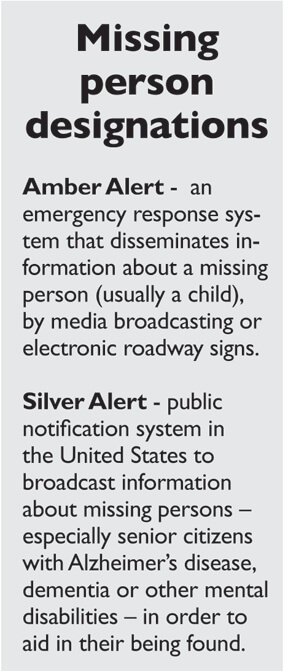By CASSIE MCKEE
Four Points News
When a Steiner Ranch man was reported missing in late September, deputies with the Travis County Sheriff’s Office were quickly on the scene. Multiple agencies assisted in the search effort including Texas Search and Rescue, Austin Fire Department, StarFlight and Travis County Parks.
As it turned out, the missing man returned home and the search was ended after multiple hours and a lot of manpower and resources. While the sheriff’s office did not identify the man or provide further details, it prompted Four Points News to sit down with former TCSO spokesperson Roger Wade to find out what goes into a missing person search.
One common misconception is that when a missing person report is made, deputies have to wait 24 hours to begin searching.
“Unlike TV cops, we don’t have to wait 24 or 48 hours,” said Wade, who has retired since this interview. “We take the information as soon as it comes in.”
When a report is made, deputies begin working to determine who the missing person is, where he or she might go and whether he or she is in danger. Depending on the type of missing person, the information is entered into the Texas Crime Information database so every law enforcement agency in the state will be able to access the records and let TCSO know if the individual is found.
In the case of a runaway report, the case is assigned to a detective. Sometimes a crime unit or crisis intervention team will get involved if they might know of some areas where the person might be. The detective will work with parents to go out and search likely areas where the teen might be. Wade said 90 times out of a 100, runaways will return home on their own. He said the family is never held responsible for the cost of a search.
“That’s your taxpayer dollars at work,” Wade said. “We’ll make every attempt to try to locate those persons.”
He added that once a runaway has been found, if he or she is out of state, it’s up to the parents to get the child.
He also pointed out that if the missing person is an adult who does not want to return home, as long as the person does not have any impairments, TCSO simply notifies the person who made the report that the missing person has been found and does not want to return home.
“A missing person is not necessary a violation of the law,” Wade said.
Wade said it’s hard to say how many missing person reports the department gets in a given month since the reports come in with different offense titles like Silver Alert, Amber Alert, runaway, missing person, and kidnapping.
Deputy Hollis search
The largest TCSO search in recent years was the search for Travis County senior deputy Jessica Hollis, who was swept away after checking a low water crossing in the Four Points area in 2014. Sadly, after three days of searching, Hollis’ body was recovered in Lake Austin.
“That was a very extensive search,” Wade said.
Numerous agencies assisted in the search including Austin Police Department, Austin Fire Department, Austin/Travis County Emergency Medical Service, Lake Travis Fire Rescue, Texas Search and Rescue, Game Wardens, U.S. Fish and Wildlife, Travis County Parks, Travis County District Attorney investigators, Travis County Search and Rescue, the Texas Department of Public Safety, Drug Enforcement Administration, Lakeway Police Department, Starflight, CapMetro, and the National Guard.
There were also 100s of volunteers searching by foot.
“It was a lot of folks concentrated in the area,” Wade said. “Our logistics had to be good so we could know where people were searching and mark off areas. That was very intense.”
Hollis was eventually found by a dive team. Wade said the department will not stop searching until a person is found or the case goes cold.
“If we believe someone is in an area, we’ll exhaust all of our resources until we’ve made sure they aren’t there,” he said. “We’ll keep looking until the case goes cold and then we’ll still continue to look from time to time.”
Four Points News submitted an open records request in an attempt to find out the cost involved with the Hollis search and the Sept. 29 Steiner Ranch search but a representative said that information is not available.
“Our Office doesn’t have responsive information for the total cost incurred,” said Kristin Yarborough, TCSO paralegal.
TCSO also would not disclose specific procedural details regarding missing person searches as the information could conceivably be used by criminal actors who are in custody of a missing or endangered person, and would reveal potential weaknesses in the specific operations employed by TCSO, including potential locations in which TCSO may deploy officers and the capabilities of law enforcement for any type of search.
Determining resources
Determining the resources involved in a search depends on how big of an area the department is searching and what resources are available.
Unlike APD, TCSO does not have a specific missing persons’ unit. TCSO also does not have its own helicopter, so it must rely on other agencies to conduct searches by air.
“We can call and ask if STAR flight or APD or DPS can send a helicopter over, though it’s not always available,” Wade said.
If it’s a recent case, TCSO may utilize its canine unit.
“Our canines are trained in patrol, narcotics and person-and-evidence searches,” Wade said. “They’re not just used for missing persons. Our dogs work everything.”
Depending on the length of the search, TCSO may ask deputies to go out and search an area.
“We have all the available deputies go out and work overtime to search an area,” Wade said.
Sometimes the department will use reverse 911, now known as Code Red, to help locate a missing person. It’s a basic program that people can register for and will allow them to receive a phone call when a search is underway in their area.
“We can send phone calls out to a certain area and say, ‘Have you seen this person?’” Wade said. “We’ve found kids this way fairly quickly.”
Regarding cost, Wade said it depends on what resources are used and the circumstances of the case. The biggest cost is typically the time of the deputies involved. He said there’s no set price or limit to what resources the department will use.
“If we’ve got an Amber Alert, we’re going to spend a lot of resources trying to locate that child,” he said.
The department also utilizes several volunteer search and rescue groups. The most well-known volunteer groups are Travis County Search and Rescue; Texas Search and Rescue, which has its own helicopter; and EquuSearch, a group based in east Texas that uses horses in their search efforts.
All the volunteer groups are self-taught in search and rescue and trained regularly to assist local law enforcement.
“We try to use the volunteer groups as much as we can,” Wade said. “The ones we have used have been excellent working with us and making sure that everything has been covered.”
TCSO still has some missing person cases that go back years. In those cases, the missing person is kept in the database and the family will check back on a yearly basis. But those are rare cases.
“For most of the missing person cases, we do get some closure one way or the other,” Wade said.


